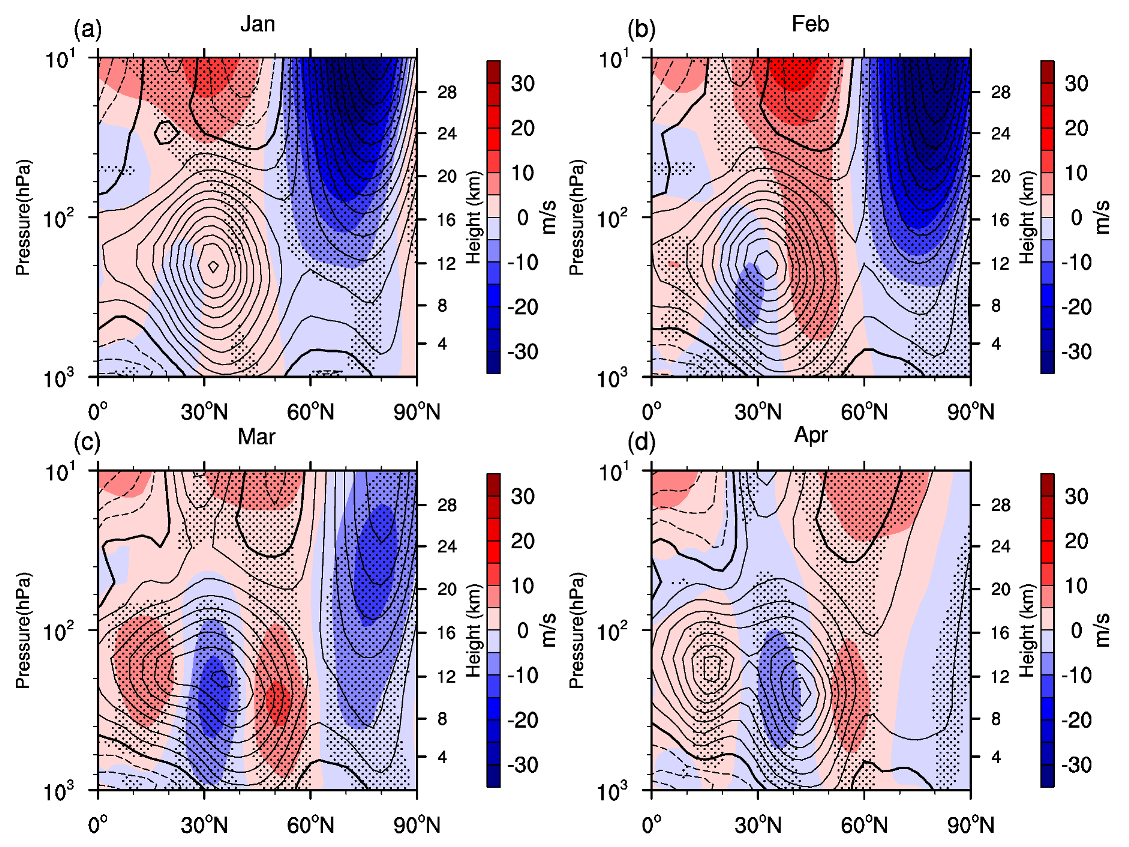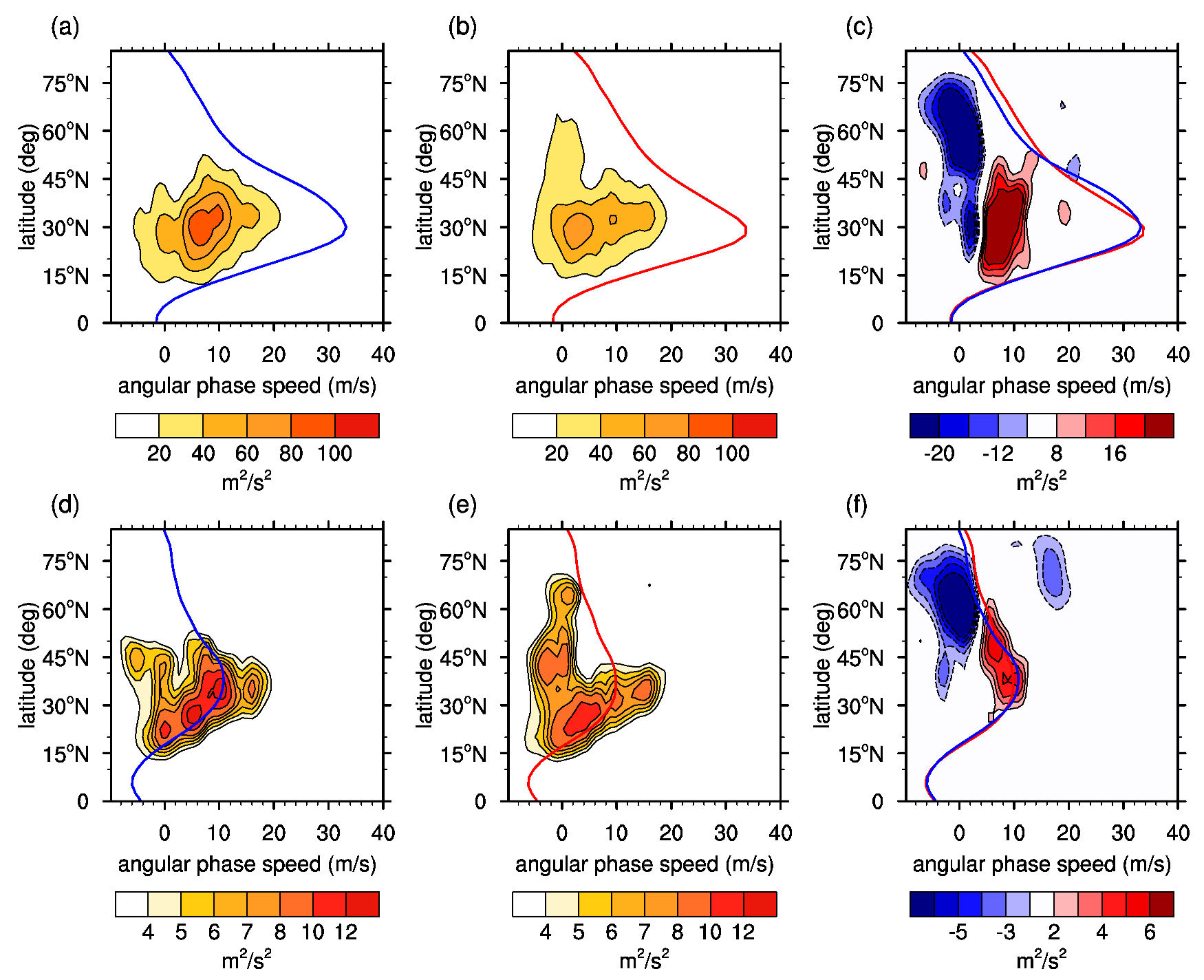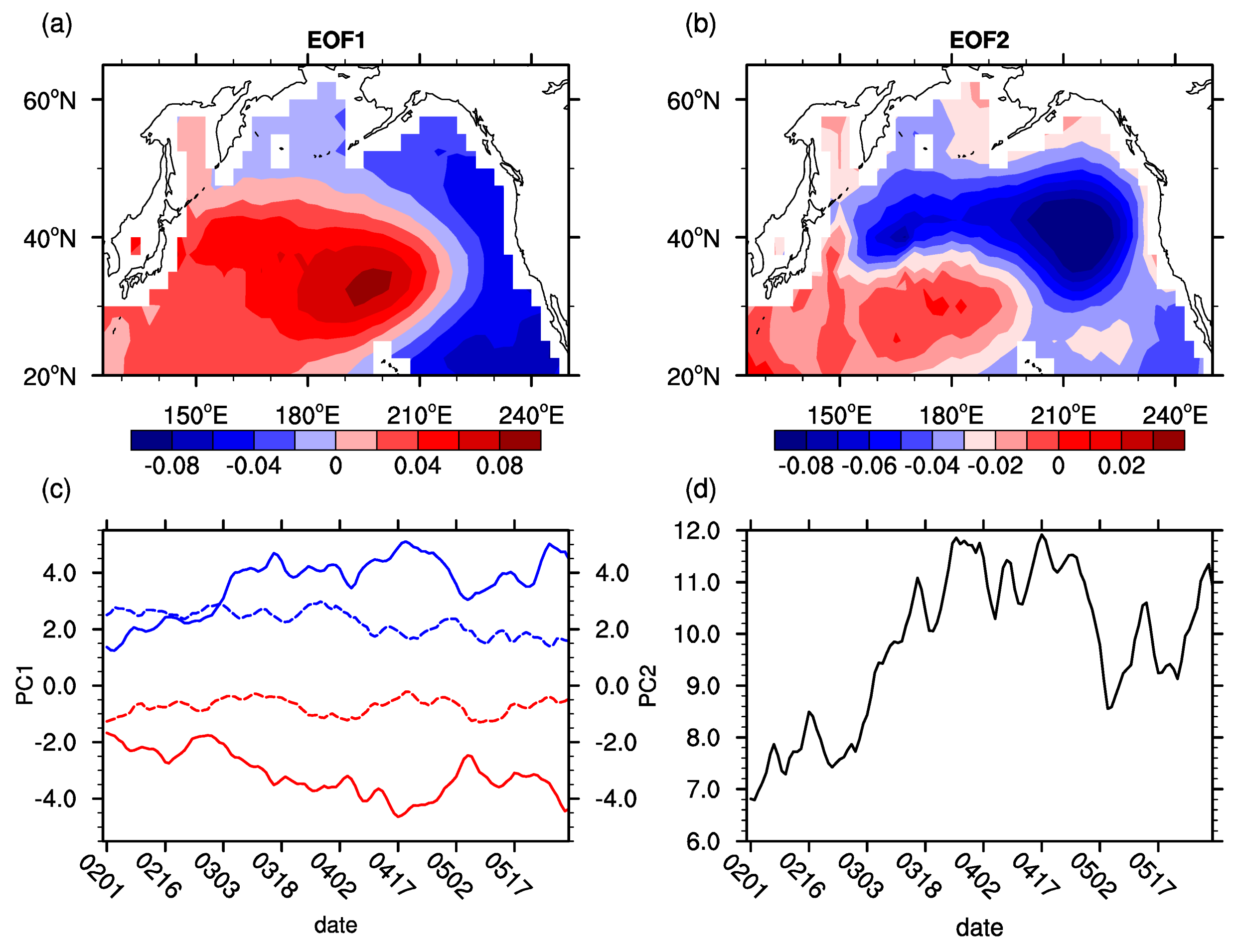Influence of Wintertime Polar Vortex Variation on the Climate over the North Pacific during Late Winter and Spring
Abstract
:1. Introduction
2. Data, Methodology, and Model
2.1. Reanalysis and SST Data
2.2. Methodology
2.3. CMCC-CMS Climate Simulation
3. Impacts of Stratospheric Polar Vortex Changes
4. Summary and Conclusions
Author Contributions
Funding
Acknowledgments
Conflicts of Interest
References
- Baldwin, M.; Dunkerton, T. Propagation of the Arctic Oscillation from the stratosphere to the troposphere. J. Geophys. Res. Atmos. 1999, 104, 30937–30946. [Google Scholar] [CrossRef]
- Baldwin, M.P.; Dunkerton, T.J. Stratospheric harbingers of anomalous weather regimes. Science 2001, 294, 581–584. [Google Scholar] [CrossRef] [PubMed]
- Hardiman, S.C.; Butchart, N.; Charltonperez, A.J.; Shaw, T.A.; Akiyoshi, H.; Baumgaertner, A.; Bekki, S.; Braesicke, P.; Chipperfield, M.; Dameris, M. Improved predictability of the troposphere using stratospheric final warmings. J. Geophys. Res. Atmos. 2011, 116, 597–616. [Google Scholar] [CrossRef]
- Tripathi, O.P.; Baldwin, M.; Charlton-Perez, A.; Charron, M.; Eckermann, S.D.; Gerber, D.; Harrison, E.G.; Jackson, D.R.; Kim, B.M.; Kuroda, Y. The predictability of the extratropical stratosphere on monthly time-scales and its impact on the skill of tropospheric forecasts. Q. J. R. Meteorol. Soc. 2015, 141, 987–1003. [Google Scholar] [CrossRef]
- Son, S.W.; Lim, Y.; Yoo, C.; Hendon, H.H.; Kim, J. Stratospheric control of the Madden–Julian oscillation. J. Clim. 2017, 30, 1909–1922. [Google Scholar] [CrossRef]
- Xie, F.; Li, J.; Sun, C.; Ding, R.; Xing, N.; Yang, Y.; Zhou, X.; Ma, X. Improved Global Surface Temperature Simulation using Stratospheric Ozone Forcing with More Accurate Variability. Sci. Rep. 2018, 8, 14474. [Google Scholar] [CrossRef]
- Waugh, D.W.; Sobel, A.H.; Polvani, L.M. What is the polar vortex, and how does it influence weather? Bull. Am. Meteorol. Soc. 2016, 98, 37–44. [Google Scholar] [CrossRef]
- Kolstad, E.W.; Breiteig, T.; Scaife, A.A. The association between stratospheric weak polar vortex events and cold air outbreaks in the Northern Hemisphere. Q. J. R. Meteorol. Soc. 2010, 136, 886–893. [Google Scholar] [CrossRef] [Green Version]
- Kim, B.M.; Son, S.W.; Min, S.K.; Jeong, J.H.; Kim, S.J.; Zhang, X.; Shim, T.; Yoon, J.H. Weakening of the stratospheric polar vortex by Arctic sea-ice loss. Nat. Commun. 2014, 5, 4646. [Google Scholar] [CrossRef] [Green Version]
- Chen, Q.; Xu, L.; Cai, H. Impact of Stratospheric Sudden Warming on East Asian Winter Monsoons. Adv. Meteorol. 2015, 2015, 640912. [Google Scholar] [CrossRef]
- Scaife, A.A.; Knight, J.R. Ensemble simulations of the cold European winter of 2005–2006. Q. J. R. Meteorol. Soc. 2010, 134, 1647–1659. [Google Scholar] [CrossRef]
- Jung, T.; Palmer, T.N.; Rodwell, M.J.; Serrar, S. Understanding the Anomalously Cold European Winter of 2005/06 Using Relaxation Experiments. Mon. Weather Rev. 2010, 138, 3157–3174. [Google Scholar] [CrossRef]
- Chen, Q.L.; Zhan, L.; Fan, G.Z.; Zhu, K.Y.; Wen, Z.; Zhu, H.Q. Indications of stratospheric anomalies in the freezing rain and snow disaster in South China, 2008. Sci. China 2011, 54, 1248. [Google Scholar] [CrossRef]
- Zhang, J.; Tian, W.; Chipperfield, M.P.; Xie, F.; Huang, J. Persistent shift of the Arctic polar vortex towards the Eurasian continent in recent decades. Nat. Clim. Chang. 2016, 6, 1094. [Google Scholar] [CrossRef]
- Schoeberl, M.R. Stratospheric Warmings: Observations and Theory (Paper 8R0642). Rev. Geophys. 1978, 16, 521–538. [Google Scholar] [CrossRef]
- Charlton, A.J.; Polvani, L.M. A New Look at Stratospheric Sudden Warmings. Part I: Climatology and Modeling Benchmarks. J. Clim. 2007, 20, 449–469. [Google Scholar] [CrossRef]
- Mitchell, D.M.; Gray, L.J.; Anstey, J.; Baldwin, M.P.; Charlton-Perez, A.J. The Influence of Stratospheric Vortex Displacements and Splits on Surface Climate. J. Clim. 2013, 26, 2668–2682. [Google Scholar] [CrossRef] [Green Version]
- Seviour, W.J.M.; Mitchell, D.M.; Gray, L.J. A practical method to identify displaced and split stratospheric polar vortex events. Geophys. Res. Lett. 2013, 40, 5268–5273. [Google Scholar] [CrossRef] [Green Version]
- Wang, L.; Chen, W. Downward Arctic Oscillation signal associated with moderate weak stratospheric polar vortex and the cold December 2009. Geophys. Res. Lett. 2010, 37, 90–98. [Google Scholar] [CrossRef]
- Vargin, P. Stratospheric Polar Vortex Splitting in December 2009. Atmos. Ocean 2015, 53, 29–41. [Google Scholar] [CrossRef]
- Tomassini, L.; Baldwin, M.P.; Bunzel, F.; Giorgetta, M. The role of stratosphere-troposphere coupling in the occurrence of extreme winter cold spells over northern Europe. J. Adv. Modeling Earth Syst. 2012, 4. [Google Scholar] [CrossRef]
- Kuroda, Y. Role of the stratosphere on the predictability of medium-range weather forecast: A case study of winter 2003–2004. Geophys. Res. Lett. 2008, 35, 402–411. [Google Scholar] [CrossRef]
- Huang, J.; Tian, W.; Zhang, J.; Qian, H.; Tian, H.; Luo, J. The Connection between Extreme Stratospheric Polar Vortex Events and Tropospheric Blockings: Stratospheric polar vortex and tropospheric blockings. Q. J. R. Meteorol. Soc. 2017, 143, 1148–1164. [Google Scholar] [CrossRef]
- Wallace, J.M.; Held, I.M.; Thompson, D.W.J. Global warming and winter weather. Science 2014, 343, 729–730. [Google Scholar] [CrossRef] [PubMed]
- Thompson, D.W.J.; Wallace, J.M. The Arctic Oscillation Signature in the Wintertime Geopotential Height and Temperature Fields. Geophys. Res. Lett. 1944, 25, 1297–1300. [Google Scholar] [CrossRef]
- Scaife, A.A.; Knight, J.R.; Vallis, G.K.; Folland, C.K. A stratospheric influence on the winter NAO and North Atlantic surface climate. Geophys. Res. Lett. 2005, 32. [Google Scholar] [CrossRef] [Green Version]
- Nakamura, T.; Yamazaki, K.; Iwamoto, K.; Honda, M.; Miyoshi, Y.; Ogawa, Y.; Ukita, J. The stratospheric pathway for Arctic impacts on midlatitude climate. Geophys. Res. Lett. 2016, 43, 3494–3501. [Google Scholar] [CrossRef] [Green Version]
- Xie, F.; Li, J.; Tian, W.; Fu, Q.; Jin, F.F.; Hu, Y.; Yang, Y. A connection from Arctic stratospheric ozone to El Niño-Southern oscillation. Environ. Res. Lett. 2016, 11, 124026. [Google Scholar] [CrossRef]
- Xie, F.; Li, J.; Zhang, J.; Tian, W.; Hu, Y.; Zhao, S.; Yang, Y. Variations in North Pacific sea surface temperature caused by Arctic stratospheric ozone anomalies. Environ. Res. Lett. 2017, 12, 114023. [Google Scholar] [CrossRef] [Green Version]
- Garfinkel, C.I. Might stratospheric variability lead to improved predictability of ENSO events? Environ. Res. Lett. 2017, 12, 031001. [Google Scholar] [CrossRef]
- Harari, O.; Garfinkel, C.I.; Ziskin Ziv, S.; Morgenstern, O.; Zeng, G.; Tilmes, S.; O’Connor, F.M. Influence of Arctic stratospheric ozone on surface climate in CCMI models. Atmos. Chem. Phys. 2019, 19, 9253–9268. [Google Scholar] [CrossRef] [Green Version]
- Black, R.X. Stratospheric forcing of surface climate in the Arctic Oscillation. J. Clim. 2002, 15, 268–277. [Google Scholar] [CrossRef]
- Gong, H.; Wang, L.; Chen, W.; Wu, R.; Zhou, W.; Liu, L.; Nath, D.; Lan, X. Diversity of the wintertime Arctic Oscillation pattern among CMIP5 models: Role of the stratospheric polar vortex. J. Clim. 2019, 32, 5235–5250. [Google Scholar] [CrossRef]
- Nie, Y.; Scaife, A.A.; Ren, H.L.; Comer, R.E.; Andrews, M.B.; Davis, P.; Martin, N. Stratospheric initial conditions provide seasonal predictability of the North Atlantic and Arctic Oscillations. Environ. Res. Lett. 2019, 14, 034006. [Google Scholar] [CrossRef]
- Nakamura, T.; Tachibana, Y.; Honda, M.; Yamane, S. Influence of the Northern Hemisphere annular mode on Enso by modulating westerly wind bursts. Geophys. Res. Lett. 2006, 33. [Google Scholar] [CrossRef]
- Chen, S.; Chen, W.; Yu, B.; Graf, H.-F. Modulation of the seasonal footprinting mechanism by the boreal spring Arctic Oscillation. Geophys. Res. Lett. 2013, 40, 6384–6389. [Google Scholar] [CrossRef]
- Kuroda, Y.; Kodera, K. Role of planetary waves in the stratosphere-troposphere coupled variability in the Northern Hemisphere winter. Geophys. Res. Lett. 1999, 26, 2375–2378. [Google Scholar] [CrossRef]
- Limpasuvan, V.; Hartmann, D.L. Wave-Maintained Annular Modes of Climate Variability. J. Clim. 2000, 13, 4414–4429. [Google Scholar] [CrossRef]
- Harnik, N.; Lindzen, R.S. The effect of reflecting surfaces on the vertical structure and variability of stratospheric planetary waves. J. Atmos. Sci. 2001, 58, 2872–2894. [Google Scholar] [CrossRef]
- Perlwitz, J.; Harnik, N. Downward coupling between the stratosphere and troposphere: The relative roles of wave and zonal mean processes. J. Clim. 2004, 17, 4902–4909. [Google Scholar] [CrossRef]
- Kanamitsu, M.; Ebisuzaki, W.; Woolen, J.; Yang, S.-K.; Hnilo, J.J.; Fiorino, M.; Potter, G.L. NCEP-DOE AMIP-II Reanalysis (R-2). Bull. Am. Meteorol. Soc. 2002, 83, 1631–1643. [Google Scholar] [CrossRef]
- Roads, J. The NCEP-NCAR, NCEP-DOE, and TRMM tropical atmosphere hydrologic cycles. J. Hydrometeorol. 2003, 4, 826–840. [Google Scholar] [CrossRef]
- Xie, P.; Arkin, P.A. Global precipitation: A 17-year monthly analysis based on gauge observations, satellite estimates, and numerical model outputs. Bull. Am. Meteorol. 1997, 78, 2539–2558. [Google Scholar] [CrossRef]
- Rayner, N.A.A.; Parker, D.E.; Horton, E.B.; Folland, C.K.; Alexander, L.V.; Rowell, D.P.; Kaplan, A. Global analyses of sea surface temperature, sea ice, and night marine air temperature since the late nineteenth century. J. Geophys. Res. Atmos. 2003, 108. [Google Scholar] [CrossRef]
- Zhang, J.; Tian, W.; Wang, Z.; Xie, F.; Wang, F. The influence of ENSO on northern midlatitude ozone during the winter to spring transition. J. Clim. 2015, 28, 4774–4793. [Google Scholar] [CrossRef]
- Randel, W.J.; Held, I.M. Phase Speed Spectra of Transient Eddy Fluxes and Critical Layer Absorption. J. Atmos. Sci 1991, 48, 688–697. [Google Scholar] [CrossRef]
- Woollings, T.; Hannachi, A.; Hoskins, B. Variability of the North Atlantic eddy-driven jet. Q. J. R. Meteorol. Soc. 2010, 136, 856–868. [Google Scholar] [CrossRef]
- Manzini, E.; Giorgetta, M.A.; Esch, M.; Kornblueh, L.; Roecknen, E. The influence of sea surface temperatures on the northern winter stratosphere: Ensemble simulations with the MAECHAM5 model. J. Clim. 2006, 19, 3863–3881. [Google Scholar] [CrossRef]
- Cagnazzo, C.; Manzini, E. Impact of the Stratosphere on the Winter Tropospheric Teleconnections between ENSO and the North Atlantic and European Region. J. Clim. 2009, 22, 1223. [Google Scholar] [CrossRef]
- Weare, B.C.; Cagnazzo, C.; Fogli, P.G.; Manzini, E.; Navarra, A. Madden-Julian Oscillation in a climate model with a well-resolved stratosphere. J. Geophys. Res. Atmos. 2012, 117. [Google Scholar] [CrossRef]
- Manzini, E.; Cagnazzo, C.; Fogli, P.G.; Bellucci, A.; Müller, W.A. Stratosphere-troposphere coupling at inter-decadal time scales: Implications for the North Atlantic Ocean. Geophys. Res. Lett. 2012, 39. [Google Scholar] [CrossRef] [Green Version]
- Davini, P.; Cagnazzo, C.; Anstey, J.A. A blocking view of the stratosphere-troposphere coupling. J. Geophys. Res. Atmos. 2014, 119, 11–100. [Google Scholar] [CrossRef]
- Madec, G.; Delecluse, P.; Imbard, M.; Lévy, C.; Madec, G.; Delecluse, P.; Imbard, M. Ocean General Circulation Model Reference Manual. Available online: https://www.researchgate.net/profile/Gurvan_Madec/publication/243055542_OPA_81_Ocean_General_Circulation_Model_reference_manual/links/02e7e51d1b695c81c5000000/OPA-81-Ocean-General-Circulation-Model-reference-manual.pdf (accessed on 29 August 2019).
- Timmermann, R.; Goosse, H.; Madec, G.; Fichefet, T.; Ethe, C.; Dulière, V. On the representation of high latitude processes in the ORCA-LIM global coupled sea ice ocean model. Ocean Model. 2005, 8, 175–201. [Google Scholar] [CrossRef]
- Fogli, P.G.; Manzini, E.; Vichi, M.; Alessandri, A.; Patara, L.; Gualdi, S.; Scoccimarro, E.; Masina, S.; Navarra, A. INGV-CMCC Carbon (ICC): A carbon cycle Earth system model. Soc. Sci. Electron. Publ. 2009. [Google Scholar] [CrossRef]
- Holton, D.; Leovy, C.B.; Holton, J.R. Middle Atmosphere Dynamics, 1st ed.; Academic Press: Cambridge, UK, 1987; Volume 40. [Google Scholar]
- Heifetz, E.; Bishop, C.H.; Hoskins, B.J.; Methven, J. The counter-propagating Rossby-wave perspective on baroclinic instability. I: Mathematical basis. Q. J. R. Meteorol. Soc. 2010, 130, 211–231. [Google Scholar] [CrossRef]
- Wittman, M.A.H.; Charlton, A.J.; Polvani, L.M. The Effect of Lower Stratospheric Shear on Baroclinic Instability. J. Atmos. Sci. 2007, 64, 479–496. [Google Scholar] [CrossRef]
- Chen, G.; Held, I.M. Phase speed spectra and the recent poleward shift of Southern Hemisphere surface westerlies. Geophys. Res. Lett. 2007, 34, 857–862. [Google Scholar] [CrossRef]
- Chhak, K.C.; Lorenzo, E.D.; Schneider, N.; Cummins, P.F. Forcing of low-frequency ocean variability in the Northeast Pacific. J. Clim. 2009, 22, 1255–1276. [Google Scholar] [CrossRef]
- Mantua, N.J.; Hare, S.R.; Zhang, Y.; Wallace, J.M.; Francis, R.C. A Pacific interdecadal climate oscillation with impacts on salmon production. Bull. Am. Meteorol. 1997, 78, 1069–1080. [Google Scholar] [CrossRef]
- Ding, R.; Li, J.; Tseng, Y.H.; Cheng, S.; Guo, Y. The Victoria mode in the North Pacific linking extratropical sea level pressure variations to ENSO. J. Geophys. Res. Atmos. 2015, 120, 27–45. [Google Scholar] [CrossRef]
- Hurwitz, M.M.; Newman, P.A.; Garfinkel, C.I. On the influence of North Pacific sea surface temperature on the Arctic winter climate. J. Geophys. Res. Atmos. 2012, 117. [Google Scholar] [CrossRef]
- Wang, W.; Matthes, K.; Omrani, N.E.; Latif, M. Decadal variability of tropical tropopause temperature and its relationship to the Pacific Decadal Oscillation. Sci. Rep. 2016, 6, 29537. [Google Scholar] [CrossRef] [PubMed] [Green Version]
- Hu, D.; Guan, Z. Decadal relationship between the stratospheric Arctic vortex and Pacific Decadal Oscillation. J. Clim. 2018, 31, 3371–3386. [Google Scholar] [CrossRef]
- Li, Y.; Tian, W.; Fei, X.; Wen, Z.; Zhang, J.; Hu, D.; Han, Y. The connection between the second leading mode of the winter North Pacific sea surface temperature anomalies and stratospheric sudden warming events. Clim. Dyn. 2018, 51, 581–595. [Google Scholar] [CrossRef]
- García-Herrera, R.; Calvo, N.; Garcia, R.R.; Giorgetta, M.A. Propagation of ENSO temperature signals into the middle atmosphere: A comparison of two general circulation models and ERA-40 reanalysis data. J. Geophys. Res. Atmos. 2006, 111. [Google Scholar] [CrossRef] [Green Version]
- Calvo, N.; Garcia, R.R.; Randel, W.J.; Marsh, D.R. Dynamical mechanism for the increase in tropical upwelling in the lowermost tropical stratosphere during warm ENSO events. J. Atmos. Sci. 2010, 67, 2331–2340. [Google Scholar] [CrossRef]
- Domeisen, D.I.; Garfinkel, C.I.; Butler, A.H. The teleconnection of El Niño Southern Oscillation to the stratosphere. Rev. Geophys. 2019, 57, 5–47. [Google Scholar] [CrossRef]
- Bjerknes, J. Atmospheric teleconnections from the equatorial Pacific. Mon Weather Rev. 1969, 97, 163–172. [Google Scholar] [CrossRef]
- Namias, J. Some statistical and synoptic characteristics associated with El Niño. J. Phys. Oceanogr. 1976, 6, 130–138. [Google Scholar] [CrossRef]
- Horel, J.D.; Wallace, J.M. Planetary-scale atmospheric phenomena associated with the Southern Oscillation. Mon. Weather Rev. 1981, 109, 813–829. [Google Scholar] [CrossRef]










© 2019 by the authors. Licensee MDPI, Basel, Switzerland. This article is an open access article distributed under the terms and conditions of the Creative Commons Attribution (CC BY) license (http://creativecommons.org/licenses/by/4.0/).
Share and Cite
Zhang, K.; Wang, T.; Xu, M.; Zhang, J. Influence of Wintertime Polar Vortex Variation on the Climate over the North Pacific during Late Winter and Spring. Atmosphere 2019, 10, 670. https://doi.org/10.3390/atmos10110670
Zhang K, Wang T, Xu M, Zhang J. Influence of Wintertime Polar Vortex Variation on the Climate over the North Pacific during Late Winter and Spring. Atmosphere. 2019; 10(11):670. https://doi.org/10.3390/atmos10110670
Chicago/Turabian StyleZhang, Kequan, Tao Wang, Mian Xu, and Jiankai Zhang. 2019. "Influence of Wintertime Polar Vortex Variation on the Climate over the North Pacific during Late Winter and Spring" Atmosphere 10, no. 11: 670. https://doi.org/10.3390/atmos10110670




